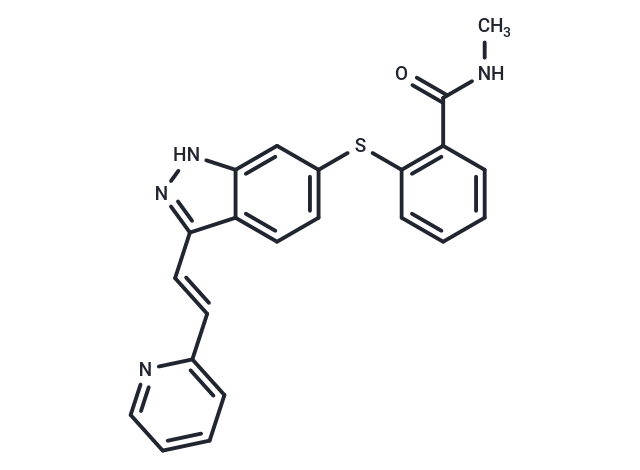Shopping Cart
- Remove All
 Your shopping cart is currently empty
Your shopping cart is currently empty

Axitinib (AG-013736) is a multi-targeted tyrosine kinase inhibitor that inhibits VEGFR1, VEGFR2, VEGFR3, and PDGFRβ (IC50=4/20/0.4/2 nM). Axitinib has antitumor activity and is used in the treatment of renal cell carcinoma.

| Pack Size | Price | Availability | Quantity |
|---|---|---|---|
| 25 mg | $33 | In Stock | |
| 50 mg | $45 | In Stock | |
| 100 mg | $61 | In Stock | |
| 200 mg | $77 | In Stock | |
| 500 mg | $150 | In Stock | |
| 1 g | $218 | In Stock | |
| 1 mL x 10 mM (in DMSO) | $48 | In Stock |
| Description | Axitinib (AG-013736) is a multi-targeted tyrosine kinase inhibitor that inhibits VEGFR1, VEGFR2, VEGFR3, and PDGFRβ (IC50=4/20/0.4/2 nM). Axitinib has antitumor activity and is used in the treatment of renal cell carcinoma. |
| Targets&IC50 | c-Kit:1.7 nM, VEGFR1/FLT1:0.1 nM, PDGFRβ:1.6 nM, VEGFR2/Flk1:0.18 nM, VEGFR2/KDR: 0.2 nM, VEGFR3: 0.1-0.3 nM |
| In vitro | METHODS: Thirteen neuroblastoma cells were treated with Tepotinib for 72 h and cell viability was measured by MTT assay. RESULTS: All cells showed reduced cell viability with IC50 values ranging from 2.4-8.5 µM.[1] METHODS: EBC-1 cells were treated with Tepotinib (0-30 µmol/L) for 3 days, and the expression levels of target proteins were detected by Western Blot. RESULTS: Tepotinib treatment induced a significant reduction in c-Met constitutive phosphorylation in EBC-1 cells with an IC50 of 9 nmol/L. Tepotinib also effectively blocked the phosphorylation of the major downstream effectors of the c-Met enzyme in EBC-1, MKN-45, and Hs746T cells in the 1-10 nmol/L range. [2] |
| In vivo | METHODS: To assay antitumor activity in vivo, Tepotinib (5-15 mg/kg) was injected once daily for 14 days into CD-1 mice bearing EBC-1 xenografts. RESULTS: Administration of 5 or 15 mg/kg of Tepotinib daily to mice bearing EBC-1 tumors effectively inhibited or completely regressed the tumors, respectively. [2] |
| Kinase Assay | Porcine aorta endothelial (PAE) cells overexpressing full-length VEGFR-2, PDGFR-β, KIT, and NIH-3T3 overexpressing murine VEGFR-2 (Flk-1) or PDGFR-α were generated as described previously. The ELISA capture plates were prepared by coating 96-well ReactiBind plates with 100 μL/well of 2.5 μg/mL anti-VEGFR-2 antibody, 0.75 μg/mL anti-PDGFR-β antibody, 0.25 μg/mL anti-PDGFR-α antibody, 0.5 μg/mL anti-KIT antibody, or 1.20 μg/mL anti-Flk-1 antibody. Measurement of RTK phosphorylation by ELISA was done as described previously [1]. |
| Cell Research | Endothelial or tumor cells were starved for 18 h in the presence of either 1% FBS (HUVEC) or 0.1% FBS (tumor cells). Axitinib was added and cells were incubated for 45 min at 37°C in the presence of 1 mmol/L Na3VO4. The appropriate growth factor was added to the cells, and after 5 min, cells were rinsed with cold PBS and lysed in the lysis buffer and a protease inhibitor cocktail. The lysates were incubated with immunoprecipitation antibodies for the intended proteins overnight at 4°C. Antibody complexes were conjugated to protein A beads and supernatants were separated by SDS-PAGE. The Super Signal West Dura kit was used to detect the chemiluminescent signal [1]. |
| Animal Research | AG-013736, a receptor kinase inhibitor of VEGFRs and, at higher doses, PDGFRs (IC50 = 0.1 nmol/L for VEGFR-1, 0.2 nmol/L for VEGFR-2, 0.1–0.3 nmol/L for VEGFR-3, and 1.6 nmol/L for PDGFRβ; ref. 18), was provided by Pfizer Global Research and given once daily by gavage in a volume of 0.13 mL. Control animals received 0.5% carboxymethylcellulose drug carrier. Irradiations were done on nonanesthetized mice using a 137Cs source operating at 2.4 Gy/min. Mice were confined to plastic jigs with tumor-bearing legs extended through an opening in the side, allowing local irradiations. Fractionated doses were given in five daily 2 Gy fractions per week (omitting weekends). For combination treatments, radiotherapy was delivered first, and AG-013736 was given within ~4 h. Mice were sacrificed, and tumors were excised and then quick frozen (using liquid nitrogen) following 1, 2, or 3 weeks of treatment [3]. |
| Alias | AG-013736 |
| Molecular Weight | 386.47 |
| Formula | C22H18N4OS |
| Cas No. | 319460-85-0 |
| Storage | store at low temperature,keep away from moisture,keep away from direct sunlight | Powder: -20°C for 3 years | In solvent: -80°C for 1 year | Shipping with blue ice. | |||||||||||||||||||||||||
| Solubility Information | DMSO: 9.7 mg/mL (25 mM) | |||||||||||||||||||||||||
Solution Preparation Table | ||||||||||||||||||||||||||
DMSO
| ||||||||||||||||||||||||||

Copyright © 2015-2024 TargetMol Chemicals Inc. All Rights Reserved.